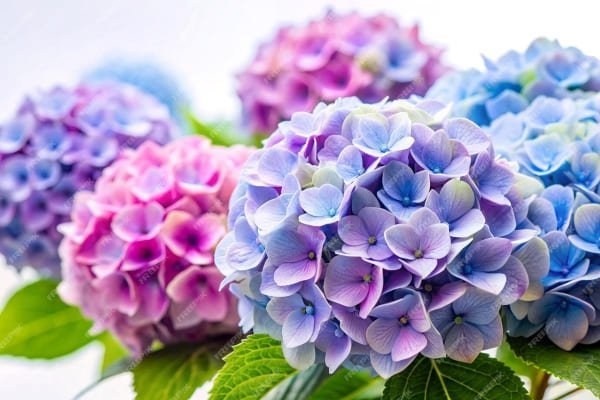Japanese Ikebana is a traditional art form that emphasizes the beauty of nature through flower arrangement. Unlike Western floral arrangements, which often focus on the abundance of flowers, Ikebana is a more minimalist approach that values simplicity, balance, and harmony. Every element, from the flowers to the vase, plays a crucial role in conveying a deeper meaning and aesthetic experience. Dried hydrangeas have found their place in this ancient practice, offering a unique texture and symbolism that aligns with the principles of Ikebana.
1. Understanding Ikebana
Before delving into the specific role of dried hydrangeas, it is important to understand the principles of Ikebana itself. Ikebana is not just about arranging flowers; it is a disciplined art form rooted in Japanese culture and Zen philosophy. The word "Ikebana" can be translated as "making flowers alive," and the practice involves creating a living sculpture that embodies the essence of nature.
A. Principles of Ikebana:
- Minimalism: Ikebana often features fewer flowers and focuses on the lines and spaces between them, creating a sense of simplicity and elegance.
- Balance and Harmony: The arrangement should be balanced yet dynamic, with a sense of movement and flow.
- Seasonality: Ikebana reflects the changing seasons, often incorporating seasonal flowers and plants.
- Symbolism: Each element in an Ikebana arrangement holds symbolic meaning, representing various aspects of life and nature.
B. The Role of Flowers in Ikebana:
- Flowers in Ikebana are not just decorative but are seen as living entities that communicate the beauty of nature. The choice of flowers, their placement, and the overall composition are all carefully considered to create a harmonious and meaningful arrangement.
2. The Significance of Hydrangeas in Japanese Culture
Hydrangeas, known as "Ajisai" in Japanese, hold a special place in Japanese culture. They are often associated with the rainy season, as they bloom during the early summer when Japan experiences its monsoon. Hydrangeas are admired for their vibrant colors, which can range from blue and purple to pink and white, depending on the soil's acidity.
A. Symbolism of Hydrangeas:
- Gratitude and Apology: Hydrangeas are often given as a gesture of gratitude or apology, reflecting their delicate and changeable nature.
- Impermanence: The changing colors of hydrangeas are seen as a symbol of impermanence, a key concept in Buddhism and Japanese aesthetics.
B. Hydrangeas in Traditional Japanese Gardens:
- Hydrangeas are commonly found in Japanese gardens, where their lush blooms and rich colors add beauty to the serene landscape. Their presence in these gardens further cements their connection to traditional Japanese aesthetics.
3. The Use of Dried Hydrangeas in Ikebana
Dried hydrangeas offer a different perspective on this beloved flower, bringing out their unique textures and muted colors. In Ikebana, dried flowers are valued for their longevity and the subtle beauty they retain long after they have been cut.
A. Why Use Dried Flowers in Ikebana?
- Durability: Dried flowers, including hydrangeas, are more durable than fresh ones, making them ideal for long-lasting arrangements.
- Subtle Beauty: The faded colors and delicate textures of dried hydrangeas align with the wabi-sabi aesthetic, which finds beauty in imperfection and transience.
- Seasonal Reflection: Dried hydrangeas can represent the transition from summer to autumn, capturing the essence of change and the passage of time.
B. Techniques for Using Dried Hydrangeas in Ikebana:
- Selecting the Right Hydrangeas: Choose hydrangeas that have been dried properly to retain their shape and color. The drying process can be done naturally by hanging the flowers upside down in a cool, dark place, or by using silica gel for a quicker method.
- Incorporating Dried Hydrangeas with Fresh Elements: Combining dried hydrangeas with fresh branches, leaves, or even other dried flowers can create a dynamic contrast that enhances the arrangement's overall composition.
- Creating Balance and Harmony: In Ikebana, the placement of each element is crucial. Dried hydrangeas can be used to create a focal point or to add texture and depth to the arrangement. Careful attention should be paid to the balance of the arrangement, ensuring that the dried flowers complement the other elements without overpowering them.
C. Examples of Dried Hydrangea Arrangements in Ikebana:
- Wabi-Sabi Arrangement: A simple arrangement featuring a single dried hydrangea bloom alongside a fresh branch of cherry blossoms. The contrast between the vibrant blossoms and the muted hydrangea creates a sense of impermanence and beauty.
- Autumn Reflection: An arrangement that combines dried hydrangeas with autumn leaves and grasses, capturing the transition from summer to autumn. The arrangement evokes a sense of nostalgia and the beauty of nature's cycles.
- Monochromatic Harmony: A minimalist arrangement using dried hydrangeas in various shades of brown and beige, complemented by dried grasses and twigs. The monochromatic color scheme and the varied textures create a serene and harmonious composition.
4. Preserving and Preparing Hydrangeas for Ikebana
The process of drying and preserving hydrangeas for Ikebana requires careful attention to detail. The goal is to maintain the flower's natural beauty while enhancing its longevity.
A. Drying Techniques:
- Air Drying: The most common method involves hanging the hydrangeas upside down in a cool, dark place for several weeks. This method helps retain the flower's shape and color.
- Silica Gel Drying: This method involves burying the hydrangea blooms in silica gel, which absorbs moisture and speeds up the drying process. This technique is ideal for preserving the flower's vibrant colors.
B. Preparing Dried Hydrangeas for Ikebana:
- Once dried, the hydrangeas should be handled with care, as they can become brittle. Before arranging them in Ikebana, it is important to trim the stems and remove any damaged petals. The dried hydrangeas can also be treated with a floral sealant to prevent them from crumbling.
5. The Aesthetic and Philosophical Significance of Dried Hydrangeas in Ikebana
The use of dried hydrangeas in Ikebana goes beyond aesthetics; it is deeply connected to Japanese philosophy and the concept of wabi-sabi.
A. Wabi-Sabi in Ikebana:
- Wabi-sabi is a Japanese aesthetic that finds beauty in imperfection, impermanence, and the natural cycle of growth and decay. Dried hydrangeas, with their faded colors and delicate textures, embody this concept, making them a perfect choice for Ikebana arrangements that seek to reflect the passage of time.
B. Symbolism in Dried Hydrangea Arrangements:
- Dried hydrangeas can symbolize the fleeting nature of life, the beauty of aging, and the acceptance of change. These themes are often explored in Ikebana, where the arrangement is not just a decorative piece but a reflection of the artist's thoughts and emotions.
C. The Emotional Impact of Dried Hydrangeas:
- The muted tones and subtle beauty of dried hydrangeas can evoke a sense of nostalgia, calm, and introspection. In an Ikebana arrangement, they can create a contemplative atmosphere, inviting viewers to pause and appreciate the transient nature of life.
6. Conclusion
Dried hydrangeas play a significant role in Japanese Ikebana, offering a unique blend of beauty, symbolism, and philosophical depth. Their use in this traditional art form reflects a deep appreciation for nature's cycles and the beauty of imperfection. Whether used as a focal point or as a complementary element, dried hydrangeas bring a sense of harmony and balance to Ikebana arrangements, making them a timeless choice for artists and enthusiasts alike. Through the careful selection, preservation, and arrangement of dried hydrangeas, Ikebana artists can create stunning compositions that resonate with the principles of wabi-sabi and the ever-changing beauty of the natural world.




